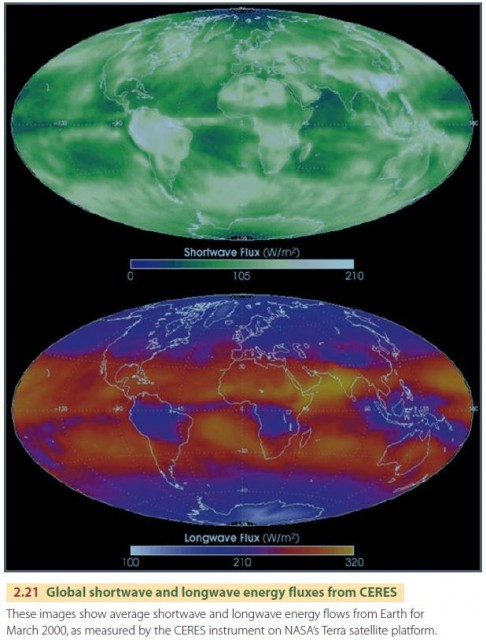CERES—Clouds and the Earth’s Radiant Energy System
The Earth's global radiation balance is the primary determinant of long-term surface temperature, which is of great importance to life on Earth. Because this balance can be affected by human activities, such as converting forests to pasturelands or releasing greenhouse gases into the atmosphere, it is important to monitor the Earth's radiation budget over time as accurately as possible.
For nearly 20 years, NASA has studied the Earth's radiation budget from space. An ongoing NASA experiment entitled CERES—Clouds and the Earth's Radiant Energy System—is placing a new generation of instruments in space that scan the Earth and measure the amount of shortwave and longwave radiation leaving the Earth at the top of the atmosphere.
Figure 2.21 shows global reflected solar energy and emitted longwave energy averaged over the month of March 2000 as obtained by CERES. The top image shows average shortwave flux (“flux” means “flow”), ranging from 0 to 210 W/m2. The largest flows occur over regions of thick clouds near the Equator, where the bright, white clouds reflect much of the solar radiation back to space. In the midlatitudes, persistent cloudiness during this month also shows up as light tones. Tropical deserts, the Sahara for example, are also bright. Snow and ice surfaces in polar regions are quite reflective, but in March the amount of radiation received in polar regions is low. As a result, they don't appear as bright in this image. Oceans, especially where skies are clear, absorb solar radiation and thus show low shortwave fluxes.

Longwave flux is shown in the bottom image on a scale from 100 to 320 W/m2. Cloudy equatorial regions have low values, showing the blanketing effect of thick clouds that trap longwave radiation beneath them. Warm tropical oceans in regions of clear sky emit the most longwave flux. Poleward, surface and atmospheric temperatures drop, so longwave energy emission also drops significantly.
As you can see from these images, clouds are very important determiners of the global radiation balance. A primary goal of the CERES experiment is to learn more about the Earth's cloud cover, which changes from minute to minute and hour to hour. This knowledge can be used to improve global climate models that predict the impact of human and natural change on the Earth's climate.
The most important contribution of CERES, however, is continuous and careful monitoring of the Earth's radiant energy flows. In this way, small, long-term changes, induced by human or natural change processes, can be detected in spite of large variations in energy flows from place to place and time to time caused by clouds.